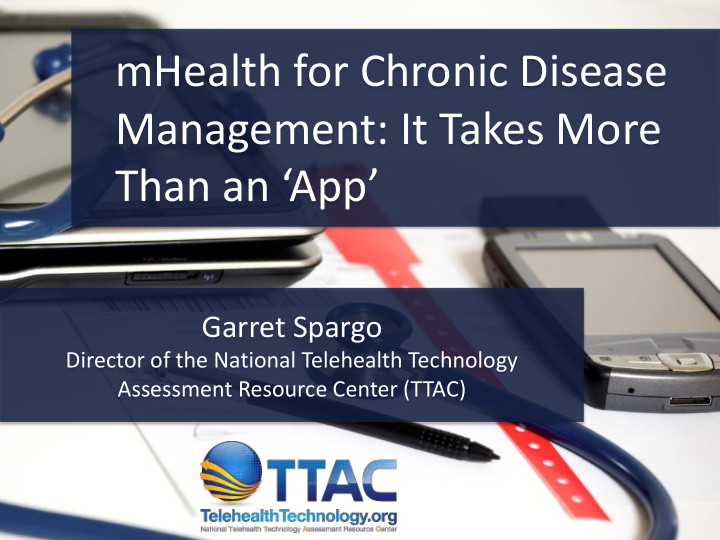



mHealth for Chronic Disease Management: It Takes More Than an ‘App’ Garret Spargo Director of the National Telehealth Technology Assessment Resource Center (TTAC)
The Evolution of Mobile Karl Arnold – “Drahtlose Telephonie” [translation: wireless telephone] in Simplicissimus 12/20/1926
The Evolution of Mobile
The Evolution of Mobile
The Evolution of Mobile
The Evolution of Mobile
The Evolution of Mobile
The Evolution of Mobile iPhone (2007) iPhone OS, iOS (1, 2, 3, 4, 5, 6, 7)
The Evolution of Mobile HTC Dream (2008) Android v1 (2008) 1, Cupcake, Donut, Éclair, Froyo, Gingerbread, Honeycomb, Ice Cream Sandwich, Jelly Bean, KitKat
The Evolution of Mobile 1G (1979 – 56 Kbit/s) 2G (1991 – 150 Kbit/s 3G (2001 – 1.4-3.1 Mbit/s) 4G LTE (2009 – 4-22 Mbit/s)
The Evolution of Mobile Google Play iTunes App Store Windows Store
The Evolution of Mobile Google Play iTunes App Store Windows Store
Today’s Talk A Definition of mHealth mHealth Technology mHealth Programs Lessons from the Literature Current Challenges
World Health Organization To date, no standardized definition of mHealth has been established
World Health Organization Mobile health (mHealth) is […] the provision of health services and information via mobile technologies such as mobile phones and Personal Digital Assistants (PDAs)
National Institutes of Health mHealth is the use of mobile and wireless devices to improve health outcomes, healthcare services and health resources
mHealth Alliance […] medical and public health practice supported by mobile devices, such as mobile phones, patient monitoring devices, tablets, personal digital assistants (PDAs), and other wireless devices
The Technology – Hardware Basic / Feature Phones Smart Phones Peripherals
The Technology – Software App Stores Application Programming Interfaces
The Technology – Servers Patient data storage / access Provider access
The Programs – SMS “Texting” Educational, encouraging, challenging Targeting behavioral change Minimal technological requirements
The Programs – Data Collection Activity trackers & calorie counters Medical device interfaces Electronic logs
The Programs – Support Apps Extension of data collection Shares results, informs of non-compliance Provides information about conditions
The Literature mHealth and Pediatric Chronic Conditions (2014) • Systematic Review on What Works, What Does Not Work, and Why of Implementation • of Mobile Health (mHealth) Projects in Africa (2014) A mHealth Application for Chronic Wound Care: Findings of a User Trial (2013) • A Data Encryption Solution for Mobile Health Apps in Cooperation Environments • (2013) Comparison of Traditional Versus Mobile App Self-Monitoring of Physical Activity and • Dietary Intake Among Overweight Adults Participating in an mHealth Weight Loss Program (2013) Contemporary Vascular Smartphone Medical Applications (2013) • Development and Evaluation of Tools for Measuring the Quality of Experience (QoE) in • mHealth Applications (2013) Hispanic Migrant Farm Workers’ Attitudes Toward Mobile Phone-Based Mapping • mHealth Research: A Decade of Evolution (2013) Older Adults are Mobile Too! Identifying the Barriers and Facilitators to Older Adults’ • Use of mHealth for Pain Management (2013)
The Literature Patient Apps for Improved Healthcare: From Novelty to Mainstream (2013) • Telehealth for Management of Chronic Health Conditions (2013) • Understanding Determinants of Consumer Mobile Health Usage Intentions (2013) • Systematic Review on What Works, What Does Not Work, and Why of Design of an • mHealth App for the Self-Management of Adolescent Type 1 Diabetes: A Pilot Study (2012) A Mobile Health Intervention for Inner City Patients with Poorly Controlled Diabetes: • Proof-of-Concept of the TExT-MED Program (2012) Advancing the Science of mHealth (2012) • Design of an mHealth App for the Self-Management of Adolescent Type 1 Diabetes: A • Pilot Study (2012) Lessons From a Community-Based mHealth Diabetes Self-Management Program: “It’s • Not Just About the Cell Phone” (2012) mHealth Consumer Apps: The Case for User-Centered Design (2012) • Designing Interventions to Overcome Poor Numeracy and Improve Medication • Adherence in Chronic Illness, Including HIV / Aids (2011)
The Lessons – Culture is Key Target patients with appropriate mHealth app Meet them where they are
The Lessons – Devices Differ BYOD, Version 2.0 Patients have very different phones Form factors and functions vary
The Lessons – No Silver Bullets You can lead a horse to water … The problem of compliance
The Lessons – Build Relationships Not technology for technology’s sake Supplement, don’t replace relationships
The Lessons – Quantity != Quality Need actionable context Who needs what, and when?
The Challenges – Too Many Apps Patients are overwhelmed Providers are overwhelmed Quality is variable across applications
The Challenges – Certification What measures do we certify against? Who determines the necessary measures? Who ensures the certifying body does it right?
The Challenges – Privacy & Security [ I am not a lawyer ] Who has access to the data? How is it protected?
The Challenges – Data Quantity Interoperability Workflows Training
The Challenges – Reimbursement Who pays for devices? Connectivity? Apps?
The Potential Increase patient compliance Kick-start data interoperability Measurably improve patient wellness
The Resources - TTAC gspargo@anthc.org (907) 729-4704 www.telehealthtechnology.org
gspargo@anthc.org (907) 729-4704 www.telehealthtechnology.org
The Resources - Other imedicalapps.com mobihealthnews.com IMS Institute for Healthcare Informatics
Any Questions?
Recommend
More recommend